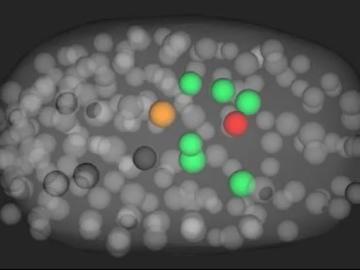
Filter News
Area of Research
- (-) Biology and Environment (37)
- (-) Supercomputing (130)
- Advanced Manufacturing (2)
- Building Technologies (1)
- Computational Biology (1)
- Computational Engineering (3)
- Computer Science (16)
- Electricity and Smart Grid (1)
- Energy Science (108)
- Energy Sciences (1)
- Functional Materials for Energy (2)
- Fusion and Fission (7)
- Fusion Energy (2)
- Isotopes (2)
- Materials (89)
- Materials for Computing (15)
- Mathematics (1)
- National Security (44)
- Neutron Science (32)
- Nuclear Science and Technology (5)
- Quantum information Science (6)
- Sensors and Controls (1)
News Topics
- (-) Computer Science (105)
- (-) Cybersecurity (9)
- (-) Energy Storage (11)
- (-) Frontier (32)
- (-) Machine Learning (20)
- (-) Physics (9)
- (-) Polymers (4)
- (-) Security (6)
- 3-D Printing/Advanced Manufacturing (13)
- Advanced Reactors (2)
- Artificial Intelligence (41)
- Big Data (29)
- Bioenergy (50)
- Biology (76)
- Biomedical (28)
- Biotechnology (15)
- Buildings (6)
- Chemical Sciences (15)
- Clean Water (11)
- Composites (5)
- Coronavirus (22)
- Critical Materials (4)
- Environment (105)
- Exascale Computing (28)
- Fusion (2)
- Grid (7)
- High-Performance Computing (56)
- Hydropower (8)
- Isotopes (3)
- Materials (24)
- Materials Science (22)
- Mathematics (5)
- Mercury (7)
- Microscopy (16)
- Molten Salt (1)
- Nanotechnology (16)
- National Security (9)
- Neutron Science (16)
- Nuclear Energy (5)
- Partnerships (6)
- Quantum Computing (20)
- Quantum Science (25)
- Simulation (26)
- Software (1)
- Space Exploration (3)
- Summit (47)
- Transportation (8)
Media Contacts

A study by researchers at the ORNL takes a fresh look at what could become the first step toward a new generation of solar batteries.

A study led by researchers at ORNL used the nation’s fastest supercomputer to close in on the answer to a central question of modern physics that could help conduct development of the next generation of energy technologies.

ORNL, TVA and TNECD were recognized by the Federal Laboratory Consortium for their impactful partnership that resulted in a record $2.3 billion investment by Ultium Cells, a General Motors and LG Energy Solution joint venture, to build a battery cell manufacturing plant in Spring Hill, Tennessee.

Scientists have developed a novel approach to computationally infer previously undetected behaviors within complex biological environments by analyzing live, time-lapsed images that show the positioning of embryonic cells in C. elegans, or roundworms. Their published methods could be used to reveal hidden biological activity.

More than 50 current employees and recent retirees from ORNL received Department of Energy Secretary’s Honor Awards from Secretary Jennifer Granholm in January as part of project teams spanning the national laboratory system. The annual awards recognized 21 teams and three individuals for service and contributions to DOE’s mission and to the benefit of the nation.

Three ORNL scientists have been elected fellows of the American Association for the Advancement of Science, or AAAS, the world’s largest general scientific society and publisher of the Science family of journals.

A rapidly emerging consensus in the scientific community predicts the future will be defined by humanity’s ability to exploit the laws of quantum mechanics.

A new version of the Energy Exascale Earth System Model, or E3SM, is two times faster than an earlier version released in 2018.

A team of scientists led by the Department of Energy’s Oak Ridge National Laboratory and the Georgia Institute of Technology is using supercomputing and revolutionary deep learning tools to predict the structures and roles of thousands of proteins with unknown functions.

The world is full of “huge, gnarly problems,” as ORNL research scientist and musician Melissa Allen-Dumas puts it — no matter what line of work you’re in. That was certainly the case when she would wrestle with a tough piece of music.


